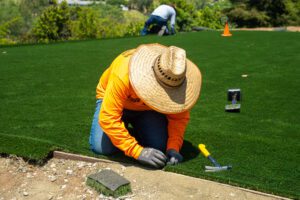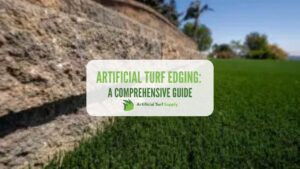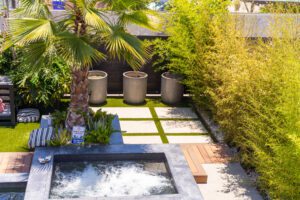As specialists of premium artificial turf, we at Artificial Turf Supply understand the significance of every detail in achieving a flawless lawn. Among the crucial steps often overlooked is artificial turf edging. It’s not just about aesthetics, but it’s about creating a boundary to enhance both the appearance and longevity of your artificial turf installation.
How To Edge Artificial Turf
Properly edged turf not only enhances the visual aspect of your outdoor space but also prevents potential issues such as weed growth and turf displacement. We’ll take you through each step, providing insights and tips to ensure a professional finish.
Step 1: Preparing the Turf Area
Before diving into the edging process, you must prepare the turf area thoroughly. Here’s how:
- Clearing debris: Begin by removing any debris, rocks, or obstacles from the turf area. Use a rake or a leaf blower to ensure the surface is clean and free of any obstructions.
- Smooth the surface: Once the debris is cleared, take the time to smooth out the surface of the soil or base material beneath the turf. This helps create a level foundation for the edging material and ensures a seamless transition between the turf and the surrounding landscape.
See More: Artificial Grass Ground Preparation
Step 2: Selecting the Appropriate Tools
Equipping yourself with the right tools is essential for a successful edging project. Here are some tools you may need:
- Shovel: A sturdy shovel is indispensable for digging trenches and shaping the edges of the turf area.
- Landscape stakes: These stakes are used to secure the edging material in place and prevent it from shifting over time.
- Edging material cutter: Depending on the type of edging material you choose, you may need a cutter to trim it to the desired length and shape.
Step 3: Installing the Artificial Turf Edging Material
Once you’ve prepared the turf area and gathered your tools, it’s time to install the edging material. Here’s how to do it:
- Digging trenches: Use a shovel to dig trenches along the perimeter of the turf area. The depth of the trenches should be slightly deeper than the thickness of the edging material.
- Placing the edging material: Carefully place the edging material into the trenches, ensuring it sits flush with the surface of the turf. If using flexible materials like a bender board, bend it to follow the contours of the turf area.
- Securing the edging: Once the edging material is in place, use landscape stakes to secure it every few feet along the length of the trench. This helps anchor the edging material and prevents it from shifting.
Step 4: Securing the Artificial Turf to the Edging
With the edging material installed, the next step is to secure the artificial turf to the edging. Here’s how:
- Trimming the turf: If necessary, trim any excess turf along the edges to ensure a clean and tidy finish.
- Securing the turf: Use landscape stakes or adhesive to secure the edges of the turf to the edging material. This helps keep the turf in place and prevents it from shifting or lifting over time.
Step 5: Tips and Tricks for a Professional Finish
To achieve a polished and professional-looking edging job, consider the following tips:
 Maintain consistency: Ensure consistency in the depth and angle of the edging throughout the installation process. This helps create clean and uniform edges along the entire perimeter of the turf area.
Maintain consistency: Ensure consistency in the depth and angle of the edging throughout the installation process. This helps create clean and uniform edges along the entire perimeter of the turf area.- Take your time: Edging can be a meticulous process, so don’t rush it. Take your time to carefully install the edging material and secure the turf, paying attention to detail every step of the way.
- Double-check for stability: Once the edging material and turf are in place, double-check to ensure everything is secure and stable. This will help prevent any issues or potential damage down the line.
By following these steps and tips, you can achieve a professional-quality edging job that enhances the appearance and longevity of your artificial turf installation.
Learn More: Installing Artificial Grass
Types of Edging Materials
When it comes to edging artificial turf, choosing the right material is crucial for achieving a seamless and aesthetically pleasing transition between your turf and the surrounding elements. Various materials offer different benefits, and understanding their characteristics can guide you in making an informed decision.
Bender Board:
- Advantages: Bender boards, typically made of flexible recycled plastic or composite materials, are popular for their flexibility. They can be easily shaped to create smooth curves, making them ideal for intricate landscape designs.
- Considerations: While bender boards offer flexibility, they may require additional stakes for reinforcement, especially in areas with high foot traffic or where the turf meets other surfaces.
Metal Edging:
- Advantages: Metal edging, often made of steel or aluminum, provides a sturdy and durable option. It offers a clean and sleek appearance, creating defined lines that enhance the overall look of the turf.
- Considerations: Metal edging may be prone to rust, particularly in regions with high humidity or frequent exposure to moisture. Additionally, its rigidity may limit its use in curved or irregularly shaped areas.
Plastic Edging:
- Advantages: Plastic edging, typically made from high-density polyethylene, is lightweight, easy to install, and cost-effective. It provides a clean and unobtrusive border for artificial turf.
- Considerations: While plastic edging is budget-friendly, it may not be as durable as other materials, and it may become brittle over time, especially in extreme weather conditions.
Recycled Plastic Edging:
- Advantages: Edging made from recycled plastic is an environmentally friendly option. It combines the benefits of plastic edging with the positive environmental impact of recycling materials.
- Considerations: While contributing to sustainability, recycled plastic edging may have similar durability concerns as standard plastic edging, so its performance may vary depending on the specific product.
Factors to Consider When Choosing the Right Edging Material
- Durability: Consider the longevity of the edging material, especially in outdoor conditions. Factors such as resistance to weather, UV rays, and wear and tear are crucial for ensuring a long-lasting and effective border.
- Flexibility: Evaluate the flexibility of the edging material, particularly if you have a landscape design that involves curves or irregular shapes. Flexible materials like bender boards can adapt to various layouts with ease.
- Aesthetic Appeal: Choose an edging material that complements the overall design and aesthetic of your landscape. The right edging enhances the visual appeal of your artificial turf, contributing to a polished and cohesive look.
- Installation Ease: Consider the ease of installation, especially if you are undertaking a DIY project. Some materials, such as plastic edging, are lightweight and easy to work with, while others, like metal, may require more effort and expertise.
- Cost: Factor in the cost of the edging material within your budget. While some materials may be more expensive upfront, their durability and long-term performance may justify the initial investment. Learn more about the cost savings of artificial grass.
By carefully considering these factors and understanding the characteristics of various edging materials, you can make an informed decision that aligns with your specific needs and preferences for artificial turf edging.
The Impact Artificial Turf Edging
Let’s explore further how the union of functionality and aesthetics comes to life through the careful integration of artificial turf edging with creative patterns, decorative stones, lighting effects, and landscape themes, as well as through real-life transformations that exemplify the transformative power of seamless edging in diverse outdoor settings.
Aesthetics and Durability of Artificial Turf Edging
Edging is not just a finishing touch; it’s a fundamental aspect of artificial turf installation that significantly influences both aesthetics and durability. Here’s a closer look at the benefits:
Aesthetic Enhancement
Edging creates clear and defined boundaries between the artificial turf and other landscape elements, enhancing the overall visual appeal of the outdoor space. A well-executed edging job contributes to a polished and professional appearance, elevating the aesthetic quality of the entire lawn.
Weed Prevention
Properly installed edging acts as a barrier, preventing weeds and unwanted vegetation from encroaching onto the artificial turf. This not only maintains a clean look but also reduces the need for constant maintenance.
Structural Support
Edging materials, when correctly installed, provide structural support to the artificial turf, preventing it from shifting or migrating over time. This enhances the longevity and durability of the entire installation.
Easy Maintenance
Edging makes maintenance tasks more manageable by clearly delineating the turf area. This facilitates easier mowing, trimming, and overall care, contributing to a well-maintained and visually pleasing lawn.
Enhancing Visual Appeal Beyond Simple Artificial Turf Edging
Creating a visually striking landscape with artificial turf goes beyond the basics. Incorporate these inspiring ideas to elevate the aesthetic appeal of your outdoor space:
Creative Patterns
Consider incorporating mosaic patterns into your edging for a unique and artistic touch. This adds an extra layer of creativity and visual interest to the border of your artificial turf.
Decorative Stones
Use decorative stones or pebbles as an edging material. This natural element not only provides a rustic charm but also complements the greenery of the artificial turf.
Lighting Effects
Install solar-powered lights along the edging to create a captivating nighttime ambiance. This not only enhances safety but also adds a touch of elegance to your outdoor space.
Integrating Artificial Turf Edging with Landscape Themes
Make your artificial turf seamlessly blend into your overall landscaping theme with thoughtful edging integration.
Modern Minimalism
Opt for sleek metal edging to complement a modern and minimalist landscape design. The clean lines will contribute to a sophisticated and contemporary aesthetic.
Rustic Charm
Use wooden bender boards for a rustic and natural look. This type of edging complements a garden with cottage-style plants and adds warmth to the overall theme.
Mediterranean Oasis
Incorporate terracotta tiles as edging for a Mediterranean-inspired theme. This choice not only defines the turf area but also adds a touch of Mediterranean charm.
Revolutionizing Landscapes with Artificial Turf Edging
In summary, recognizing the significance of meticulously edging artificial turf is paramount. This guide has meticulously outlined the crucial steps in the process, covering everything from preparing the turf area to choosing the right tools and installing the edging material.
The importance of proper edging cannot be overstated. By dedicating time and effort to this initial stage, you set the foundation for a flawlessly edged artificial turf that not only enhances the aesthetics but also ensures the long-lasting allure of your outdoor space.
Ready to transform your landscape? Contact Artificial Turf Supply today for a free quote and take the first step towards beautiful artificial turf edging.




